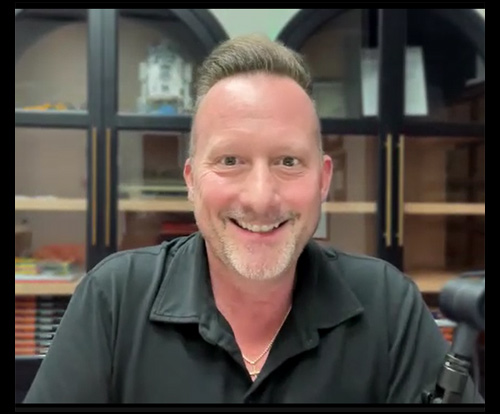Thought Leadership Studio Podcast Episodes:
Mastering Entrepreneurial Problem-Solving with Chris H. Davenport II
Episode 90 - Leveraging Systems Thinking, Root Cause Analysis, and Leadership Clarity to Tackle Business Challenges and Unlock Sustainable Success

#coaching, #consulting, #entrepreneurship, #influence, #innovation, #insight, #interviews, #leadership, #management, #mindset, #paradigmshifts, #problemsolving, #strategicthoughtleadership, #systemsthinking, #thoughtleadership
Or Click here to listen or subscribe on appWhat this episode will do for you
:- Understand Systems Thinking in Leadership: Learn how adopting a systems-level perspective can help leaders address root causes and prevent recurring issues in their organizations.
- Develop a Problem-Solving Mindset: Discover Chris’s techniques for separating emotion from analysis, enabling calm, objective decision-making under pressure.
- Uncover Deeper Issues: Explore how tools like mirroring, cognitive behavioral therapy, and the Socratic method help reveal hidden challenges and limiting beliefs.
- Empower Teams to Solve Problems: Gain insights into guiding teams to find their own solutions by fostering trust and critical thinking.
- Shift from Symptoms to Systems: Understand why focusing on the root cause, rather than surface-level symptoms, leads to more sustainable success.
- Build Strategic Habits for Leadership: Learn actionable strategies to develop habits that enhance clarity, objectivity, and effective problem-solving.
Chris H Davenport II.
In this episode, I’m thrilled to welcome Chris H. Davenport II, an expert in entrepreneurial problem-solving and systems thinking.
How does a systems view enhance Strategic Thought Leadership (STL)?
Strategic Thought Leadership leverages systemic insights to inspire transformative solutions in audience and marketplace perception. A leader can study the thinking of a market segment in ways similar to how Chris studies systemic issues underlying business problems.
Chris is a lifelong entrepreneur and EOS (Entrepreneurial Operating System) implementer who scaled the company, 3i International, by 1000%. Known for his calm, analytical approach, Chris helps CEOs and business leaders tackle complex challenges by uncovering systemic issues and eliminating limiting beliefs.
In this conversation, Chris shares how tools like cognitive behavioral therapy, mirroring, and the Socratic method enable leaders to detach from emotional narratives, see problems clearly, and build sustainable solutions.
If you’re ready to elevate your leadership by solving problems at their source, this episode offers practical insights and actionable strategies to help you think systemically and lead strategically.
Some of Chris's coordinates:
Curated Transcript of Interview with Chris H Davenport II
The following partial transcript is lightly edited for clarity - the full interview is on audio. Click here to listen.
Chris McNeil: I'm Chris McNeil, with Thought Leadership Studio, and I'm sitting across Zoom with Chris H. Davenport II, a lifelong entrepreneur and executive coach known for solving complex business challenges. And don't we all have those?
Chris launched his entrepreneurial journey in college later scaled 3I International by 1000%, earning the nicknames, the Wolf and the Cleaner for its problem solving expertise. As an EOS coach, Chris helps CEOs and business leaders achieve their goals through accountability and strategic guidance with decades of experience. He empowers leaders to unlock their potential and drive success. So this will be all about unlocking your potential as a listener and driving your success. Looking forward to exploring all this with you. Chris. Welcome.
 Chris H Davenport II: Thank you, Chris. How are you doing today? .
Chris H Davenport II: Thank you, Chris. How are you doing today? .
Chris McNeil: I'm great. So to give our listener a little context for where you're coming from, was there a pivotal moment in your life? I know you started the entrepreneurial journey really young, but was there a pivotal moment or event or circumstance or insight that was pivotal to you in this set you on the path that you're on today?
Root Cause Problem-Solving for Entrepreneurial Success
Chris H Davenport II: That's a great question. There are probably a few, but to go back to that first one, I would say it was figuring out that I could solve problems at that point in time with technology. And it was just so interesting to me, the things that I could do just on my own and applying the principles I learned. Everybody says those math classes you take and calculus, it's all kind of a waste, but it really enhanced my problem solving abilities.
 And I look back on that and appreciate all of those tough math courses that I had to take, and it really transformed the way that my brain worked and seeing a problem getting to the root of the problem and solving it so it doesn't come back. And I just did that over and over again on a micro scale. And I'd have to say that was the pivotal moment for me as figuring out I could do that.
And I look back on that and appreciate all of those tough math courses that I had to take, and it really transformed the way that my brain worked and seeing a problem getting to the root of the problem and solving it so it doesn't come back. And I just did that over and over again on a micro scale. And I'd have to say that was the pivotal moment for me as figuring out I could do that.
Chris McNeil: Awesome. And that's kind of a great entrepreneurial truth, isn't it? When we face a problem, I think it was Peter Drucker that said, when you face a management problem, you don't want to just solve the problem, then you want to solve all future recurrences of the problem.
Chris H Davenport II: That's right.
Chris McNeil: So you've got to look underneath to the roots, not just the tree itself.
Chris H Davenport II: Definitely.
Chris McNeil: Is there an example you can share with a listener of that kind of analysis, what it revealed? I know you'd want to hide any confidential client info, so keeping this generals makes you comfortable.
Chris H Davenport II: Well, definitely thinking back to a couple of the difficult issues that I solved, probably I'd have to say there was a problem that I was introduced to that it was actually during my journey in 3I International and it was actually a competitor that reached out to us that they couldn't solve a problem and it was a problem with technology and systems were down and they really couldn't, the company wasn't functioning.
There was lawsuits being thrown back and forth, the threaten of lawsuits. So the tensions, you could cut the air with a knife in the room walking into this. But that's where I feel like that I thrive. I thrive on difficult situations and I think it's part of growing up. The household I grew up in was tumultuous all the time and there was tension. So to take a positive from that, I deal with those situations quite well.
And what I do is I think that people get wrapped up in that emotional part of, oh my gosh, what else could go wrong or what am I going to do? I have no idea. And I step into that problem and I don't really feel those things at that moment in time. It's like everything goes quiet. So I'd say to the listener, if you can figure out the ability just to put those emotions aside and just read the problem for what it is at face value and start at the lowest possible place that you can with the problem, even if you think you've addressed those issues as low as, Hey, is it plugged in?
And I know that's a huge joke in it circles, Hey, is it plugged in? But I'm serious when I say start there, you would be amazed at what I've seen. And it comes down to a physical layer issue. So what I do is I look at a problem from the basic elements of whatever the situation is, and I work my way up in a very systematic approach from there. And typically I end up getting, so I start below where the roots are and I work my way up into the roots into the tree. And I find the problem that way.
Chris McNeil: That's a useful skillset.
Chris H Davenport II: Yes. And that's what I've based my entire professional career on and in different ways. But this one problem, the systems were down, everyone thought there was a power surge. Everyone thought that everything was fried. The reality is it was just they panicked. They didn't realize that they had to go in and reattach a volume like a storage device.
And I did that and everything was immediately accessible and they'd been down for two weeks and lost hundreds of thousands of dollars. And it was a crazy scenario, but it took minutes to solve that.
The Skill of Calm: Ignoring Chaos to Focus
Chris McNeil: So it's the application of grace under pressure?
Chris H Davenport II: Yes, yes. And people under pressure, a lot of times they crack. But I think that all of us have this ability if we just pause for a moment and we don't succumb to the emotional components of what's going on. And this is also difficult because you have other parties and they're trying to take their bag of anxiety and their bag of anger or whatever their emotion is, and they're trying to give it to you, but it's not yours.
So you just have to say no, and don't take on that bag because the only thing it's going to do, it's going to slow you down in solving the problem. It's going to encumber you with all of their emotions plus your emotions, plus the need to solve the problem. You're going to take all of that on, and so your chances are just out the window at that point.
Chris McNeil: Well, can we dive a little deeper into that skillset? I think it's extremely valuable, especially given the context of entrepreneurism, because the tendency of entrepreneurs to have the big dreams, take the big risk and think I've got to focus on the positive, which there's some truth in that.
 Obviously you want to frame things positively, but to neglect the problems that will grow over time without being able to take that calm, cool, collected, analytical look for the most simple path to resolution first without the emotion getting in the way kind of mindset. So to explore that, can you think of one particular time when you did that and what were you thinking as that problem was brought to you?
Obviously you want to frame things positively, but to neglect the problems that will grow over time without being able to take that calm, cool, collected, analytical look for the most simple path to resolution first without the emotion getting in the way kind of mindset. So to explore that, can you think of one particular time when you did that and what were you thinking as that problem was brought to you?
How did you frame it or what questions did you ask yourself or how did you see it to maintain this calm in the midst of turbulence?
Chris H Davenport II: What I do in these situations where I'm brought in, I ignore the emotion, I ignore that it's happening.
Chris McNeil: How do you do that?
Chris H Davenport II: I think it, honestly, it's from just from an early age of having to ignore those things through my upbringing. But I think that all of us can develop this ability, and there's something called CBT or it's short for cognitive behavioral therapy, and I'm not a therapist, so I'm not licensed, but these are tools that I have used to get better at this.
And there's something called an automatic thought record. So all of us want to go, we naturally have pathways in our brain that are built based on our experiences, based on what we've learned and the people we're around and how they react to situations. Then we come up with how we handle things on our own.
And that's both good and bad. And sometimes along the way, you pick up some habits where you overreact to certain situations. There's these things called reality distortions and CBT, and one of them is catastrophizing. And I think Chris, this is the one you you're referring to is where people just think the worst outcome. So when you're walking into something, a lot of times we have, like you're saying, you want to be positive, but a lot of times we walk in with, oh my gosh, this whole thing could burn down.
That's catastrophizing. So what you have to do when you walk into a situation, what I do is I assess the evidence to support. If I start to feel that, okay, where's the evidence to support? Do I see something on fire like physically or is the person or the problem, the pieces of the problem in the room? If they are, then there's something to work with. So I'm thinking if I'm working to work around thinking the worst, well, I have all of the pieces here in front of me, so it can't be that bad.
Getting Out of the Story: Seeing Problems from a Detached Perspective
Chris McNeil: Let me stop you just for a second because you said something very helpful there. I think what I'm understanding is one of the first things you do is get out of the story that's being told and look at "What can I experience directly through my senses? What can I see that's actually going on?"
Chris H Davenport II: Yes, Chris, that's exactly what I'm trying to articulate. And I think you've come up with a simpler way to say it for the listeners, and you kind of take yourself out of that story and look above, almost from a drone perspective looking down at it. And so you're in a balcony view, you're out of the emotion, you're out of the problem for a moment, but you're looking at it, you're assessing what's there. And then you look for if feelings aren't bad.
 A lot of these people, they think, oh gosh, I can't feel this way. It's wrong.
A lot of these people, they think, oh gosh, I can't feel this way. It's wrong.
Well, you feel the way that you feel, but the method I'm talking about is just to correct a distortion. So if you are in a problem and you feel like the world's coming to an end, you need to remove yourself from that for a moment, process your feeling, and then look if there's evidence to support that feeling. And if there's evidence against it, argue for it and argue against it. And then typically your thought or your feeling is going to be vastly different at that point after you take just a moment to do that.
Chris McNeil: That makes perfect sense. So getting out of the story, trusting your senses, directly analyzing what I'm getting is analysis of emotion. So you're able to just ask for emotion through analyzing it, maybe internally verbalizing it, here's what I'm feeling, but that's just an emotion that's not dictating things and being out of the narrative, seeing things for what they are and what you can experience directly, but then taking that distant perspective, that detached watching from a distance ...
Chris H Davenport II: That's key.
Chris McNeil: Yeah, and I know a little bit about CBT, it's got a lot of similarities with NLP. I've heard it say that the branch of psychology, this closest to neuro-linguistic programming, and we talk a lot about, which I'm very familiar with, we talk a lot about taking what's called the third perspective, the third position where you're not in the problem, you're watching it from a distance, watching the players without any emotional involvement and gathering. You gather more information from there.
Chris H Davenport II: You can. Yeah, that's very similar to that. I just think it's a tool that a lot of people, even I know that people know this, but it's underutilized because in the moment our brains don't just come out and say, Hey, remember you have this method that you can use. So you have to form a habit around it when you're solving problems.
Chris McNeil: Sure. That makes sense. And it doesn't because it's unfamiliar, it may not feel natural the first few times it comes. And since you're doing coaching and bringing these ... - I see that maybe more as a consulting piece than a coaching piece in some ways and bringing you in to solve a problem because they know that you have the skillset that enables you to do that.
And we're breaking that skillset down into separating from the narrative, seeing things for what they are, taking a distant perspective, I want you to gathered this information.
Pulling Back the Curtain: Solutions Through Dialogue
What are the next stages from there?
Chris H Davenport II: Then I basically take an approach with the emotion pulled out of it and just look at the evidence of the problem that's in front of me. In the IT space, it's easier to some extent because you're dealing with hardware or software and it only does, it serves a certain function and it does those functions. So to break that down, you can get very technical and figure out what's happening. Now in the coaching side, you're working with people and that proves to be a little more difficult because people, they share with you certain pieces of information.
And then also a lot of times people are withholding information, sometimes they're withholding information that they don't mean to withhold. And so you're dealing with a multifaceted, much more complex than technology. And so in the session room with a team, I'm working to pull things out of people in a way that builds trust and helps them to solve the problem.
 Because in that room, unlike in technology in that room, I can't solve their problem for them. I have to teach them how to solve their own problems because after our session, they go back to their role and I go to meet another client. And so I work to pull out things from them, evidence from them that will help them. And I usually use a Socratic approach. I ask questions that get them thinking.
Because in that room, unlike in technology in that room, I can't solve their problem for them. I have to teach them how to solve their own problems because after our session, they go back to their role and I go to meet another client. And so I work to pull out things from them, evidence from them that will help them. And I usually use a Socratic approach. I ask questions that get them thinking.
I don't tell, don't teach. Even if I see, a lot of times I'll see the solution that's right there. And this is hard for me sometimes because I care about these people, I want them to do well, but I know if I just give them the answer, it's not going to fix the root of the problem. And so I really work to question them, to show them things to demonstrate, to do what's called mirroring, reflect back to them what they've said to make them know that someone in the room is listening to them. A lot of times people get stuck in a problem and they want to talk through it, and there's nobody listening, and that's another issue. So I worked through those things kind of systematically in my head to solve a problem with them so they can move on to the next one.
Chris McNeil: So in that sense, are you solving problems on the human level of self-limiting belief systems, for example?
Chris H Davenport II: Yes. I think that's a good way to frame it because we all get, even I get in my own way and I work on this with someone that coaches me, and so to continue to sharpen my tools that I use to help others, and a lot of times we don't see what's right in front of us. And it's typically the same thing as the previous example. It's an emotion that's in the way that's preventing us. It's a distortion that's preventing us from seeing the path forward that will get us to solve.
Chris McNeil: Well, that's the human condition to a large extent, isn't it? I can't imagine anybody listening to this who can't find something in their experience to relate to when we've gotten in our own way because of mental habits.
Chris H Davenport II: Yes.
Using Mirroring and Questions to Reveal Hidden Systemic Issues
Chris McNeil: So how do you help people unlock these mental habits?
Chris H Davenport II: I use active listening techniques. There's a book called Never Split the Difference by Chris Voss, and he talks about something called mirroring, and he uses it in a standpoint of negotiating. And you may think for a moment, well, why is Chris talking about negotiating when he's talking about solving problems? A lot of times solving a problem does require negotiation with yourself and with the people I'm coaching.
 So I'm using these tactics to in essence negotiate with them. So to get them to see the problem in a different framework, because a lot of times they're focusing on, Hey, we don't have enough sales or we're not making our numbers. That's the problem to them. Just to use an example, and you've heard this, everybody says they want more sales. That's not the real problem. And Chris, I know you know this, but you have to negotiate with that person that sees the problem that way. So maybe a visionary is saying, we're not selling enough. We need to sell more.
So I'm using these tactics to in essence negotiate with them. So to get them to see the problem in a different framework, because a lot of times they're focusing on, Hey, we don't have enough sales or we're not making our numbers. That's the problem to them. Just to use an example, and you've heard this, everybody says they want more sales. That's not the real problem. And Chris, I know you know this, but you have to negotiate with that person that sees the problem that way. So maybe a visionary is saying, we're not selling enough. We need to sell more.
But the problem is deeper than that. The problem is an issue with a process. The problem could be we're not recruiting for the right type of people. It could be our scorecard is not measuring the right levers to get us there. It could be we're spending one to 2% of revenue on marketing, which is not nearly enough to grow. It's always deeper than that. And so it's negotiating with that person or that leader in the room to get them there without just telling them, Hey Chris, you're just not spending enough on marketing.
They have to know that and think that themselves to see that problem in order to then start to solve it. So a lot of times they're not even seeing the real problem. And so when you're trying to work on a problem, that's not even the real issue at hand, you're going to get nowhere with that.
Chris McNeil: So for the listener who may be now thinking, yep, this might apply to my situation, what are some specific questions that you might ask to help unfurl these deeper root causes?
Chris H Davenport II: I would ask, have you removed yourself out of the situation and really had a look at all of the systems in play in this certain problem? And I would ask, well, was there a time in the past where this did work well? And I would ask them, tell me about that. I would ask your competitors, do you go to trade shows? Do you go to places? What are they doing? And do they seem to have these same problems?
I'd start to help them build evidence in their head about the situation to really see it clearly instead of just internalizing it as their problem alone and in the way that they see it. Just using the external factors to the benefit to really paint a picture of what is really going on and what is really causing the problem that they're, the result is what they're complaining about, but there's a problem that's creating that result that they don't like.
Chris McNeil: So it is moving from cause and effect to more of a systems view?
***************************************
The transcript is lightly edited for clarity and is a partial transcript- the full interview is on audio. Click here to listen.
***************************************
Free Stuff and Offers Mentioned in Podcast
***************************************
***************************************